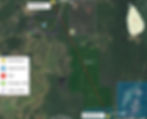
PATCH FOREST PROJECT - SIGIRIYA
2024 Update: The observations at our long-running properties in the Sigiriya region were fairly consistent with the previous year. We counted > 1300 remote camera 24-hr periods.
The Dehigahaela resident female (“Daria”) was re photo-captured but no leopard evidence at Pidurangala. It is now over 7 years that “Daria” has been occupying this range.
The main note of difference between 2023 and 2024 was the much increased activity rate at Dehigahaela, with 16 photo-captures of “Daria” for a RAI > 2 which is considerably higher than any previous year.
This is likely due to “Daria” having cubs, likely born in or around the monitored property.

Other wildcats-
At Dehigahaela, a single adult male fishing cat was photo-captured in April and December of 2024, with a single jungle cat detected in February. Rusty-spotted cats were detected throughout the year, but again, only at Dehigahaela
2023 Update: While the Sigiriya patch forests at Pidurangala have low recorded leopard residency, possibly indicating negative influences, one resident leopard–“Daria”–has been consistently monitored in this location for 6 years. The area is home to pangolins, jackals, golden-palm civets, peacocks, elephants, and langurs. In 2022, a photo-capture revealed a mating between the tufted grey langur and endangered purple-faced langur. This rare interspecies mating, although having been observed previously by WWCT scientists in another location, is unusual, perhaps an abnormality that rarely occurs between similar yet distinct species.
2022 Update: The long-term monitoring of this area continues from the stations at Pidurangala and Dehigaha Ela. Over the course of 2021, there have been very few sightings of leopards made. One of the female leopards spotted in 2018 has been seen again, excitingly, at the Pidurangala site. There also seems to be a younger leopard using the Dehiga Ela site.
Introduction & Background
In mid-2017, the WWCT commenced research within two Back of Beyond properties in Sigiriya – Pidurangala and Dehigaha Ela – under the Patch Forest Project. The aim of this initiative was to document the wildlife that use these forest patches. Since then, the leopard and all three of Sri Lanka’s small wild cats have been documented on these lands. This confirms the value of patch forests for the continued existence of these cats, and the important role they play in providing movement corridors.
Results of Ongoing Work
The continued monitoring of these lands has proven fruitful. As of May of 2019, we have been able to ascertain that all of Sri Lanka’s wild cats continue to use these patch forests. We have observed the same female leopard “Diya” using this land over the past two years. Additionally, we have noted the same male leopard “Pilar” using both patch forests as well, with three other leopards also moving through these lands, albeit infrequently. This evidence of continued use reiterates just how important these small parcels of land are for leopards in allowing them safe passage and additional space for survival.
Future Direction
These small patch forests are proving to be essential for wild cats, especially the wide-ranging leopard, serving as dispersal routes and refuges between larger protected forestscapes. As such, the WWCT is encouraging the establishment of a chain of such patch forests, to increase connectivity and forest cover of Sri Lanka’s wilderness areas. To that end, with the help and participation of interested landowners like Back of Beyond, the WWCT hopes to elevate the status of patch forests to obtain better levels of protection for the leopard and other wildlife.
For a more detailed account of the research conducted in this area, please see the 2021 Annual Report.




